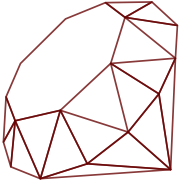Ruby's Struct class is a convenient way to create Ruby classes, which already have some attributes defined. If you are not familiar with structs, you should watch Avdi Grimm's introduction to structs!
But in many cases there is something better than structs:
Gems that Define Attributes for "Plain Old Ruby Objects"
Instead of using a specialized struct-class (which has different semantics), you could also go with normal Ruby classes. What follows is a collection of gems you could use for this purpose.
At the bottom, there are also some tips, when to use structs and what to bear in mind regarding structs.
Virtus
virtus: Attributes on Steroids for Plain Old Ruby Objects
require 'virtus'
class Person
include Virtus.model
attribute :name
attribute :age
end
Person.new(name: "Jan", age: 26)
# => #<Person:0x00000001ad85a8 @name="Jan", @age=26>
Active Attr
active_attr: What ActiveModel left out
require 'active_attr'
class Person
include ActiveAttr::MassAssignment
attr_accessor :name, :age
end
Person.new(name: "Jan", age: 26)
# => #<Person:0x00000002464f18 @name="Jan", @age=26>
Fast Attributes
fast_attributes: FastAttributes adds attributes with their types to the class
require 'fast_attributes'
class Person
extend FastAttributes
define_attributes initialize: true do
attribute :name, Object
attribute :age, Object
end
end
Person.new(name: "Jan", age: 26)
# => #<Person @name="Jan", @age=26>
Attrio
attrio: Attributes for plain old Ruby objects. No dependencies, only simplicity and clearness.
require 'attrio'
class Person
include Attrio
define_attributes do
attr :name
attr :age
end
def initialize(attributes = {})
self.attributes = attributes
end
def attributes=(attributes = {})
attributes.each do |attr,value|
self.send("#{attr}=", value) if self.respond_to?("#{attr}=")
end
end
end
Person.new(name: "Jan", age: 26)
# => <Person name: "Jan", age: 26>
attr_extras
attr_extras: Takes some boilerplate out of Ruby with methods like attr_initialize.
require 'attr_extras'
class Person
attr_initialize :name, :age
attr_reader :name, :age
end
Person.new("Jan", 26)
# => #<Person:0x0000000216ed40 @name="Jan", @age=26>
Concord
concord: Mixin to ease compositions under ruby
require 'concord'
class Person
include Concord.new(:name, :age)
end
Person.new("Jan", 26)
# => #<Person name="Jan" age=26>
Fatter Attr
fattr: fattr.rb is a "fatter attr" for ruby and borrows heavily from the metakoans.rb ruby quiz
require 'fattr'
class Person
fattrs :name, :age
end
person = Person.new
person.name = "Jan"
person.age = 26
person
# => #<Person:0x0000000147d7a8 @name="Jan", @age=26>
Anima
anima: Object initializer from attributes hash
require 'anima'
class Person
include Anima.new(:name, :age)
end
Person.new(name: "Jan", age: 26)
# => #<Person name="Jan" age=26>
KWAttr
kwattr: attr_reader + initialize with keyword arguments
require 'kwattr'
class Person
kwattr :name, :age
end
Person.new(name: "Jan", age: 26)
# => #<Person:0x00000002602988 @name="Jan", @age=26>
dry-struct
dry-struct: dry-struct is a gem built on top of dry-types which provides virtus-like DSL for defining typed struct classes.
require "dry-struct"
module Types
include Dry::Types()
end
class Person < Dry::Struct
attribute :name, Types::Strict::String.optional
attribute :age, Types::Coercible::Integer
end
Person.new(name: "Jan", age: 26)
# => #<Person name="Jan" age=26>
Structs are Still Useful… as Value Objects
Structs are different from normal Ruby classes, but they are still very useful for creating value objects. Value objects should be immutable and the following gems assist you in creating read-only objects with a Struct-like API:
Values
values: Simple immutable value objects for ruby (the readme is longer than the code)
require 'values'
Person = Value.new(:name, :age)
Person.new("Jan", 26) # => <Person name="Jan", age=26>
Immutable Struct
immutable_struct: An immutable version of Ruby's Struct class
require 'immutable_struct'
Person = ImmutableStruct.new(:name, :age)
Person.new("Jan", 26) # => #<struct Person name="Jan", age=26>
Value Struct
value_struct: Read-only structs in Ruby
require 'value_struct'
Person = ValueStruct.new(:name, :age)
Person.new("Jan", 26) # => #<ValueStruct Person name="Jan", age=26>
Why Not Structs Everywhere?
- You cannot access its instance variables directly
- Structs have their own methods (like
[], a getter for variables), which might not always be useful - Pitfalls when creating structs with custom behavior (see below)
The different ways to initialize a Struct:
Inherit
One way to add custom methods to a struct is to directly sub-class it:
class Person < Struct.new(:name, :age)
def name_and_age
"#{name}, #{age}"
end
end
The bad thing about this is that it will add an additional entry to your ancestor chain:
Person.ancestors # => [Person, #<Class:0x00000001612140>, Struct, ...]
Block
This can be avoided by passing a block to the initializer:
Person = Struct.new(:name, :age) do
def name_and_age
"#{name}, #{age}"
end
end
However, you got a new problem with this approach: You are not in the define a class scope. This can be confusing when working with constants:
Person = Struct.new(:name, :age) do
MAXIMUM_AGE = 120
end
This will create a top-level constant MAXIMUM_AGE instead of a namespaced Person::MAXIMUM_AGE one.
Reopen
The approach that avoids both problems, is a little bit more verbose, but well readable:
Person = Struct.new(:name, :age)
class Person
def name_and_age
"#{name}, #{age}"
end
end
It also seems to perform slightly better than the other options.
Further Reading
- Wikipedia: Plain old data structure
- Ruby Quiz: Implementing #attribute
- Article: Structs inside out
- Article: Struct inheritance is overused
More Idiosyncratic Ruby
- Please Comment on GitHub
- Next Article: Symbolic Reservations
- Previous Article: Stream Editing
